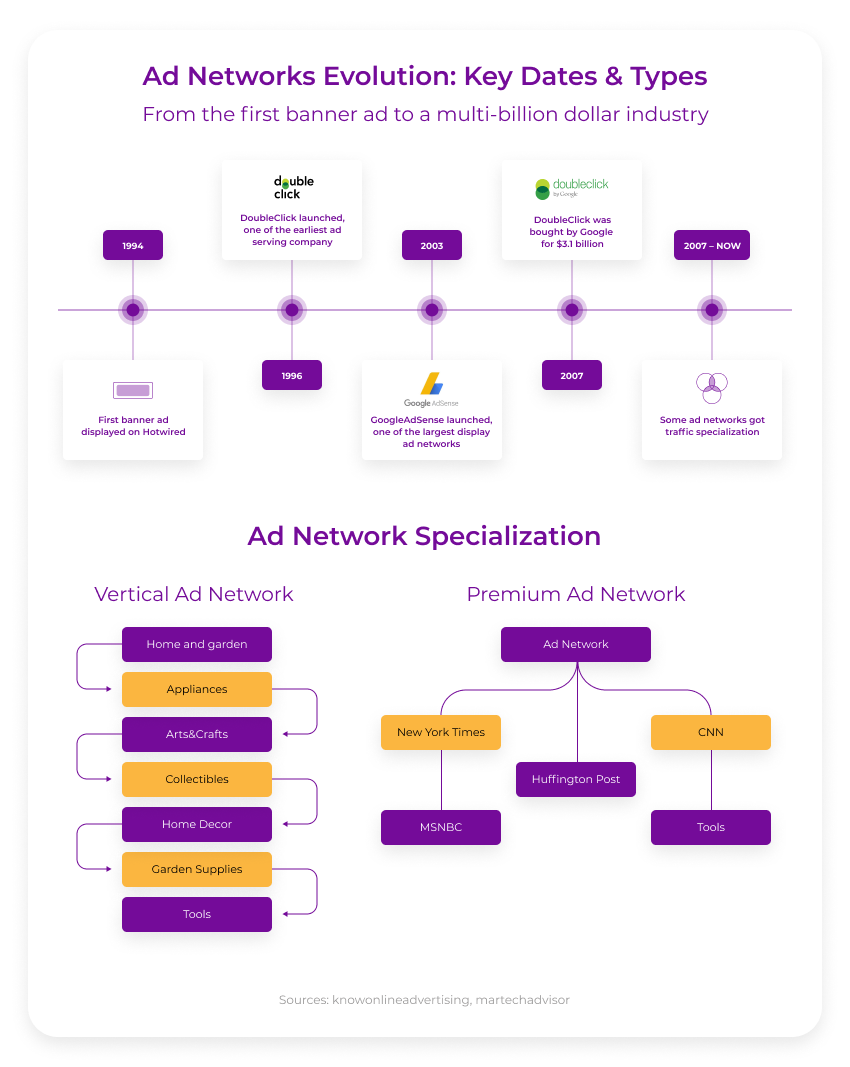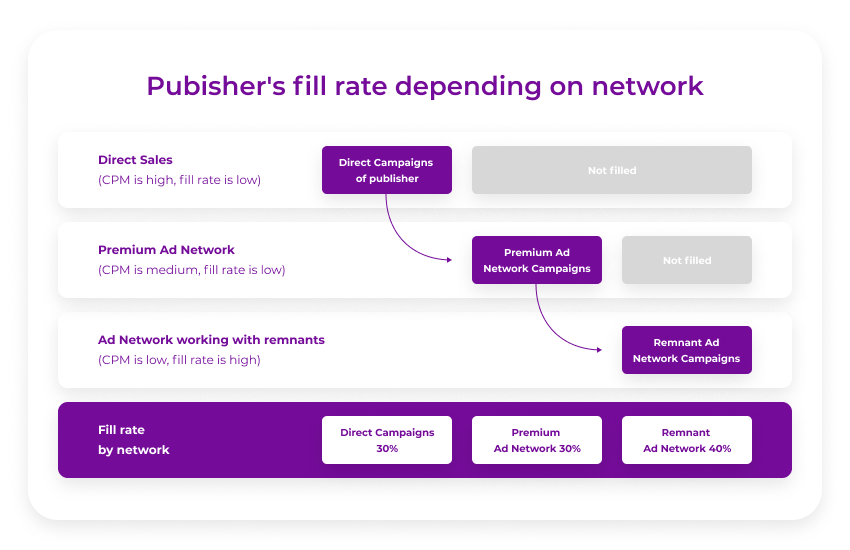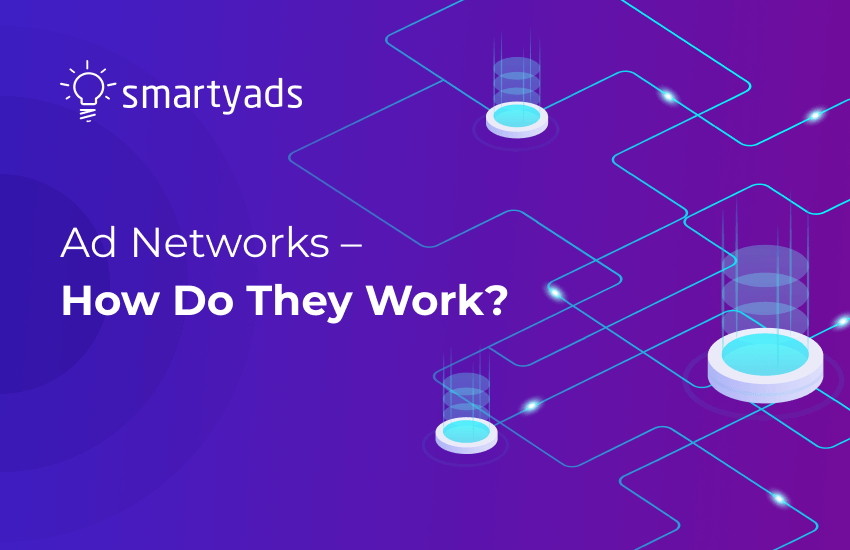Ad networks have been around since the dawn of digital advertising. Once publishers started to explore opportunities for inventory monetization, they realized that the process of selling their inventory could be much more convenient. This could be achieved by creating a place where the inventory is gathered together and sold to the interested advertisers. Both sides win from this initiative, as advertisers don’t have to spend much time looking for suitable ad placement while publishers don’t have to waste the inventory unsold via direct deals. And that’s where ad networks came in. To understand what is network advertising and its purpose, let us first start with ad network definition.
What Is an Ad Network?
In general, online ads network is an intermediary platform where ad inventory is collected from publishers and then sold to advertisers. Ad network is an indispensable part of the programmatic ecosystem, as they offer secure buyers for publishers and reputable inventory for advertisers. The concept arrived in the mid-90s during the active evolution of digital advertising. Now, it is used for digital advertising exclusively. Initially, these platforms were used to collect remnant inventory across multiple publishers who didn’t sell it via direct sales. Then, it was offered to multiple advertisers at a lower price. Nowadays, this situation is changing as more and more ad networks tend to focus on premium inventory from top-tier publishers and offer exclusive deals to the advertisers who are ready to pay more. Okay, so now that we have network advertising definition, one can make a conclusion that ads network can mediate media-buying by gathering remnant or premium inventory from publishers and then selling it to the advertisers who are looking for secure advertising space. But isn’t it the same thing that SSPs or ad servers do? Let’s find out the difference.
What Is the Difference between an …
- Ad Network vs Ad Server?
As the industry started to grow more complex, the number of ad tech platforms also started to grow and nowadays it becomes more and more difficult to differentiate them. The difference is not that hard to tell once we get a clear definition of what is an ad server. An ad server is a piece of ad tech used to host, manage and distribute ads and ad campaigns across various platforms, websites, and apps. They are also sometimes called “ad tracking systems” or “campaign management platforms” which underlines that they are primarily used for management, storage, and service of ad campaigns and creatives. In contrast, the ad network’s main function is to manage the buying process between advertisers and publishers. Although both the ad networks and ad servers are parts of ad tech, their function and purpose differ significantly.
- Ad Network vs SSP?
One could probably notice that both ads networks and SSPs are used to collect and sell publishers’ inventory, so on the general level, these pieces of ad tech are quite similar. On a more in-depth level, however, there are a number of significant differences in terms of their clients, functionality and other factors. Typically, SSPs are used to sell ads via programmatic technology. In order to handle and optimize this process, SSPs use machine-learning algorithms and real-time bidding. With the advertiser network, things are slightly different, as for some of them many optimization tasks must be done manually and their typical users are now premium publishers and advertisers. Most ad networks use direct deals only for premium inventory, leaving other arrangements for real-time bidding platforms. On top of it, SSPs only work with the supply-side (publishers), while ad networks are used by both parties, so their function is more comparable to the combination of SSP with the DSP. For some advertisers, DSP vs Ad Network is a hard choice and others prefer to use both - the right choice always depends on your business needs.
- Ad Network vs Ad Exchange?
Now, this is the tough one, since the line between an online ad network and ad exchange is not so clear. Both are solutions that gather inventory from publishers and sell it to advertisers, and both can work with DSPs and SSPs. We have thoroughly compared ad network vs ad exchange in a separate blog post, so let’s take a quick look to differentiate the two. An ad exchange is a marketplace created for both sides of the media trading, where parties can trade any type of inventory without mediators, so both sides know who they are trading with. In contrast, the online ad network is usually a company that gathers publishers and advertisers based on specific categories of advertisement. Ad networks work as an intermediary between the demand and supply and often use ad exchanges themselves to aggregate suitable inventory.
Evolution of online Ad Networks
Before we move on to more practical questions, such as how ad networks work or how to choose the right one for your business, let us have a glance at the past to trace the evolution of online ad networks and their further development. Since the dawn of digital advertising in the mid-1990s, ad networking has become the center of media-trading. The era of digital advertising started in October 1994, when the first commercial website, Hotwired, displayed the first banner ad, purchased by AT&T. This idea didn’t go unnoticed and other websites started to make use of this opportunity, as well.
At first, the click-through rate of banner ads was quite high (about 44% of people actually clicked on that first ad). So, as the number of publishers increased, many advertisers became interested in this advertising medium. For each new deal, however, without network advertisement, advertisers had to look for an appropriate inventory and contact each publisher separately, so media-buying wasn’t so fast and easy back then. In 1996 DoubleClick was launched and it was one of the first attempts to arrange the process and parties of online advertising. The company functioned as an online advertising network of publishers, that attracted demand and enabled ad performance tracking and reporting with their newly-developed DART (Dynamic Advertising Reporting and Targeting) technology. The pricing was calculated by the CPM model, which was used for their email marketing services as well. DoubleClick was then bought by Google for $3.1 billion in 2007. In the meantime, Google AdSense was launched in 2003 and by now it is one of the biggest online advertising networks complemented by DoubleClick as a premium network.

Today it is not uncommon that advertisers buy ad space through display ad networks. In fact, the market of digital advertising is so huge, that network ads tend to specialize and focus on more specific areas. For example, one ad network works exclusively with mobile advertising, while others only deliver video ads. Some brands themselves as website advertising networks, while others prefer to work as a remnant ad network. This specialization makes the market even more structured, as now advertisers can, for example, find a specific ad network that supplies only premium video inventory. This way, they don’t have to spend time sifting through dozens of ad networks in search of this specific supply, while publishers can be sure their inventory won’t be wasted. Such a proprietary display ad network can become a significant source of additional revenue, so it might be a good idea to create your own ad network to aggregate only specific traffic and sell it to demand partners.
How Does an Ad Network Work?
Now that we know what are ad networks and how they evolved, we can move into more comprehensive analysis and have a look at how do ad networks work. Gathering publishers At first, an ad network gathers a large list of publishers interested in selling their inventory on an auction basis. Normally, a publisher network earns profits by getting a share of ad revenue from selling inventory as packaged impressions.
Choosing inventory
Then, advertisers who are looking for an inventory choose an advertising publisher network. They use ad network software. Through the dashboard they access campaign-management panels and set up campaigns where they indicate their requirements for the inventory. These include budget and pricing model, targeting or retargeting options, as well as frequency caps and others. Many advertisers use multiple ad networks combined with direct deals with publishers. That’s why they also add tracking pixels from third-party ad servers for reporting and measurements of campaigns and tracking ad network performance.
Making a deal
When demand and supply sides match, details of the ad stored on the ad network are delivered to publishers. Publishers insert ad tags provided by an ad network into their web pages which allow them to automatically fetch and display ad creatives to their visitors when called upon.
Maintaining the campaign
After the ad is published, the campaign-management panel on an ad network allows advertisers to switch between multiple creatives. When ad networks were first introduced, publishers used just one direct ad network to increase their yield by selling the remnant inventory. As the industry grew, their fill rates started to drop, so publishers turned to multiple ad networks using some of them to trade premium inventory and the others for regular or remnant. When the inventory is sequentially offered to the advertisers in priority order, this strategy of media trading is called waterfalling and is opposed to header bidding, which is often more transparent, as all of the inventory at auction is offered simultaneously.

How do advertisers and publishers benefit from ad networks?
Access to the wider
market With ad networks, both advertisers and publishers get more opportunities to buy or sell ad spaces. For publishers, there is a good chance to increase their revenue dramatically by offering premium or remnant inventory. Ad networks ensure that publishers get the highest paying bids. At the same time, internet advertisers work through ad networks, so they can easily find any specific type of inventory in accordance with their budget.
Increased ROI
For both parties, wider opportunities also mean higher revenue. Publishers put up their unsold inventory on RTB auction or pre-sale their premium spaces for a good value directly. In any case, ad networks serve as a significant addition to their revenue from advertising. For advertisers, benefits depend on the quality of ads, but with precise matching powered by ad networks, at least they are able to choose the most profitable deals.
Saves time and effort
Automatic matching of publishers and advertisers is hard to overestimate. The main benefit of ad networks for advertisers is that there is now no need to manually look for suitable deals or favorable prices - all of this is done automatically by an ad network. Impressions from the best publishers are now easily accessible to anyone ready to pay for them. For publishers, this is a solid ground ensuring that most of their inventory will be sold for the best price.
How to choose the best ad network?
There are many factors to consider when choosing an ad network. To make a well-considered decision, one must not only have a clear understanding of what is ad network. It is essential to choose and understand their business goals, target audience, favorable digital ad formats, targeting, suitable business verticals, reporting options, and pricing models. It is important to remember that there are different types of ad networks and some of them can be more suitable for your specific business goals. Some of the most popular types of ad networks include:
Premium ad network. Those networks only work with inventory from top-tier publishers. They are usually very selective about their partners and the quality of their inventory. These are also useful for publishers who want to preserve premium pricing in exchange for exclusive access to the inventory.
Vertical ad network. These include fashion, business, automobiles, and technology - any website or brand working in particular niche can enter the network. This type is very useful if you have a niche-oriented website or are interested in this kind of inventory for your advertising campaign. Choosing the right topic-specific network advertisements can save you lots of time and sometimes even give you clear access to your target audience.
Specialized ad networks. Similarly to vertical advertising networks, these are usually restricted to some specific type of inventory. An example of the inventory-specific ad network can be a network that only works with video ads or mobile ad formats. As with vertical networks, choosing the right network can make media-trading much more effective and if you can’t find the one you are looking for, you can always opt for white label.
To conclude
Ad network is a useful tool for both advertisers and publishers. It can gather inventory based on certain criteria and sell it for the best price that suits advertisers and publishers alike. Nowadays, as the market has evolved, the number of ad networks continues to grow, so most of them started to specialize and focus on specific verticals and types of inventory. A well-developed niche-specific advertising network can provide your business with additional revenue stream. With white label open marketplace, there is no need to invest lots of time and money into the development process. At SmartyAds, we are dedicated to delivering high-quality pre-built customizable advertising solutions.
Contact us today and build your custom White Label ad network, designed and maintained by professionals.




